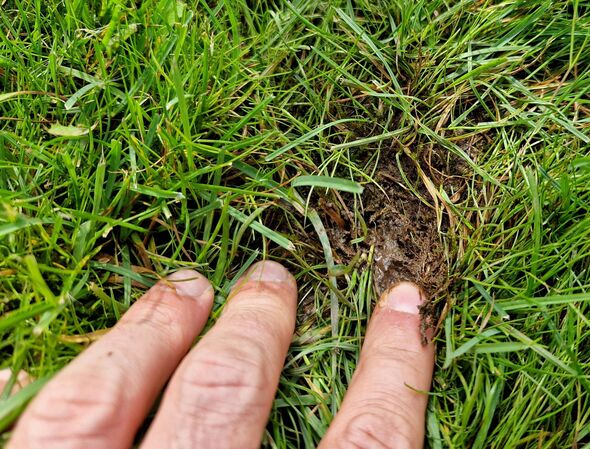Lifestyle
Expert Reveals Instant Solutions for Reviving Brown Lawn Patches

As summer approaches its end, many homeowners are left grappling with discoloured patches on their lawns. These brown spots can signal underlying issues that require immediate attention. According to horticultural expert Phil Catron, president and founder of NaturaLawn of America, various factors contribute to this lawn distress, particularly during the transition from summer to autumn.
Understanding the Causes of Lawn Damage
During the summer months, both drought conditions and excessive moisture can lead to significant grass damage. Catron highlighted that the combination of “warm, humid weather” often paves the way for fungal infections, which manifest as unsightly brown patches on lawns. He shared insights with Martha Stewart on three common diseases that affect turf.
The first, known as brown patch disease, creates irregular areas of discoloured grass that become apparent when the turf is waterlogged. Another issue, summer patch, manifests as sparse grass that turns yellow before deteriorating to a brown hue. Pythium blight, also referred to as “grease spot” or “cottony blight,” presents sunken, brown zones on lawns, often accompanied by a slimy coating on grass stems.
Effective Treatment Strategies
Addressing these issues requires a tailored approach, as there is no one-size-fits-all solution. Catron emphasized the importance of improving air circulation and soil drainage as critical first steps. He cautioned against excessive fertilisation, which can exacerbate problems, and encouraged the use of fungicides after consulting with a local gardening specialist to identify the specific type of fungus present.
“Keep an eye on lawn conditions and be proactive about addressing any signs of disease to minimise damage and improve recovery chances,” Catron advised. Quick intervention is essential; untreated fungal infections can lead to permanent grass loss.
Repairing Lawn Damage
In cases where brown patches are identified as fungal, immediate action is paramount. The Royal Horticultural Society (RHS) recommends treating diseased areas with fungicides and then reseeding or patching them. Homeowners can use turf from other parts of their lawn or, if available, fresh turf for repairs. The RHS noted, “The latter gives instant results, but sowing seed may be easier and cheaper if you have no spare turf to use as a patch.”
Alternative Causes of Brown Patches
While fungal infections are a primary concern, other factors can also lead to brown patches. Lucie Bradley, a gardening expert from Easy Garden Irrigation, pointed out that pet urine can severely damage grass due to its high nitrogen content. “While it can act as a fertiliser in small amounts, it can burn when concentrated, creating dead patches on the lawn,” Bradley explained.
Although reseeding and patching are effective solutions for areas affected by pet urine, homeowners may need to be vigilant in monitoring their pets to prevent further damage.
In conclusion, maintaining a healthy lawn requires ongoing attention and care, especially as the seasons change. By understanding the causes of brown patches and implementing swift treatment strategies, homeowners can restore their lawns to a vibrant and healthy state.
-

 World2 days ago
World2 days agoCoronation Street’s Shocking Murder Twist Reveals Family Secrets
-

 Entertainment4 months ago
Entertainment4 months agoKate Garraway Sells £2 Million Home Amid Financial Struggles
-

 Entertainment3 months ago
Entertainment3 months agoAnn Ming Reflects on ITV’s ‘I Fought the Law’ Drama
-

 Health3 months ago
Health3 months agoKatie Price Faces New Health Concerns After Cancer Symptoms Resurface
-

 Entertainment3 weeks ago
Entertainment3 weeks agoCoronation Street Fans React as Todd Faces Heartbreaking Choice
-

 World3 weeks ago
World3 weeks agoBailey Announces Heartbreaking Split from Rebecca After Reunion
-

 Entertainment5 days ago
Entertainment5 days agoTwo Stars Evicted from I’m A Celebrity Just Days Before Finale
-

 World5 days ago
World5 days agoKevin Sinfield Exceeds Fundraising Goal Ahead of Final Marathons
-

 Entertainment3 months ago
Entertainment3 months agoCoronation Street’s Carl Webster Faces Trouble with New Affairs
-

 Entertainment3 months ago
Entertainment3 months agoWhere is Tinder Swindler Simon Leviev? Latest Updates Revealed
-

 Entertainment4 months ago
Entertainment4 months agoMarkiplier Addresses AI Controversy During Livestream Response
-

 Science2 months ago
Science2 months agoBrian Cox Addresses Claims of Alien Probe in 3I/ATLAS Discovery











